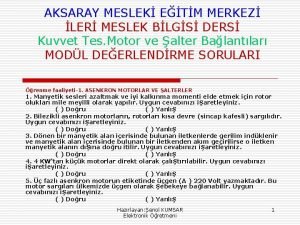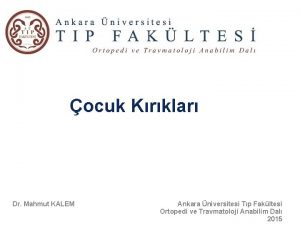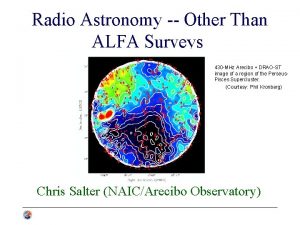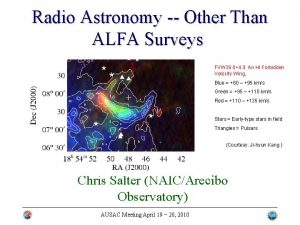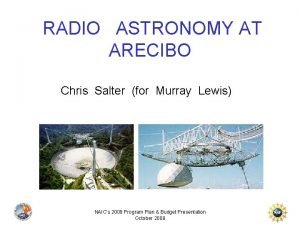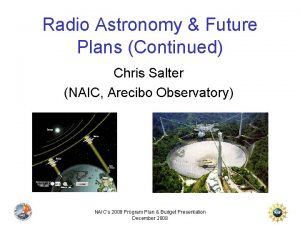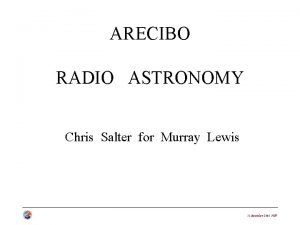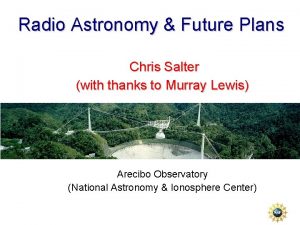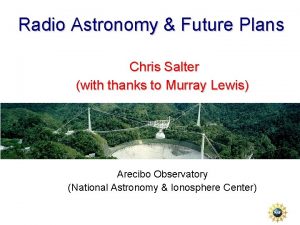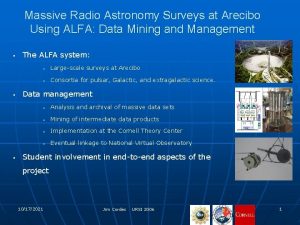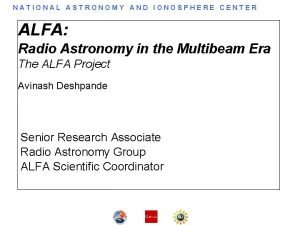Radio Astronomy Other Than ALFA Surveys Chris Salter












- Slides: 12

Radio Astronomy -- Other Than ALFA Surveys Chris Salter (NAIC/Arecibo Observatory)

The Rules of the Game • Pre-Nov 2006: -- 50% of R. A. telescope time for non ALFAsurvey astronomy (~2400 hr per yr). -- Rx available: 327, 430 & 610 MHz; LBW, SBH, CBH & XB. • Post-Nov 2006: -- 20% of R. A. telescope time for non ALFAsurvey astronomy (~750 hr per yr). -- Rx available: 327 & 430 MHz; LBW, CB & XB; (SBW, SBH & CBH on “campaign” basis).

Pulsar Study: The “Planets Pulsar” Alex Wolszczan is completing a 17 -yr study of the “planets pulsar”, PSR B 1257+12. His timing fits includes; • All PSR parameters • Astrometric parameters • Three planets (including the mutual perturbations of Planets b & c) 430 -MHz Raw Residuals 1400 -MHz Raw Residuals • DM variations (3 rd panel). Highlights of 17 -yr Study of B 1257+12 • First exoplanets. • First detection of planets in mean motion Residuals including DM Variations resonance (MMR 3: 2). • First multiplanet system. • First terrestrial-mass system. • First dynamical analog of the inner solar system (scaled down by a factor of ~2). Dispersion Measure (DM) Variations

Continuum Studies Combining DRAO Interferometer and Arecibo 400 -MHz data, Kronberg et al. have imaged an 8º region in the P-P supercluster to examine the nature of the low-level emission. The Arecibo images were CLEANed before being combined with those from DRAO. The angular resolution of the image is 10 arcmin. Minchin et al observed galaxies from the Scuba Local Universe Galaxy Survey (SLUGS) at 3, 5, 7 & 9 GHz to characterize their synchrotron emission to find its contribution to their 850 µm fluxes. This allowed corrected estimates of their cold dust masses.

HI emission from Disk Galaxies at z~0. 2 B. Catinella (MPA, Arecibo), M. Haynes, R. Giovanelli (Cornell), J. Gardner, A. Connolly (UPitt) Ø Sample selected from SDSS according to redshift (0. 16<z<0. 27), optical (Hα) emission line strength, inclination (>45 o), disk morphology, and relative isolation. Ø Observations in standard position-switching mode, L-band wide. Ø 41 galaxies targeted. Ø 26 detections + 8 tentative ones Ø HI mass 3 − 8 × 1010 M סּ Ø ON-source integration time between 1 and 4 hr per object Ø 280 hr telescope time including overheads.

SDSS ARECIBO z=0. 195 SDSS 0. 203 0. 219 Catinella et al. in preparation ARECIBO z=0. 224 0. 245 0. 262

Gas fraction vs stellar mass Evolution effects? z ~ 0. 2 Need a fair sample of massive (HI, M*), z~0 galaxies for comparison!! z~0 Virgo cluster Black: Virgo cluster (GOLDMINE + ALFALFA, Gavazzi et al. 2008) Catinella et al. in preparation

HI from Black-hole Host Galaxies Ho, Darling and Greene have made a large survey of 154 nearby Type-1 (broad-lined) AGNs whose black-hole masses and accretion rates are known. This enables them to constrain a number of properties of relevance to the relationship between BHs and their hosts. HI was detected in a high percentage of the targets. HI spectra yield: • Maximum rotation velocity of disk. • Estimate of galaxy luminosity via Tully-Fisher. • Using the optical disk size, an estimate of the dynamical mass of the galaxy. • A first-order estimate for the cold-gas content of the galaxy. Ho, Darling & Greene

HI from Black-hole Host Galaxies II B-band Tully-Fisher relation for sample. Apart from larger scatter, No gross differences between active And inactive galaxies. Black-hole mass vs Dynamical mass of host galaxy Distribution of MHI/LB for the host galaxies and a large sample of inactive galaxies. Similar distribution for later types, but early type active galaxies appear more gas-rich. Ho, Darling & Greene AUSAC Meeting · March 17 -18, 2008

Molecular Line Studies: IRAS 18566+0408 • No. of Galactic H 2 CO masers = 7 • A recent Arecibo H 2 CO survey of low-mass star forming regions showed these masers are exclusively ` associated with high-mass star formation. The H 2 CO maser in IRAS 18566+0408 was discovered at Arecibo in 2002. Three short-term H CO flares (∆t<3 months) have 2 been observed to date via systematic Arecibo monitoring. The flare amplitudes appear to be linearly decreasing. The outbursts appear periodic (P ~ 8 months) The next flare is predicted to occur in Apr 08, and will be looked for. The H CO flares are time-correlated with 6. 67 -GHz 2 CH 3 OH flares. Most of the CH 3 OH frequency components show flares that are delayed by a month, but one is prompt. High resolution follow-up with the EVLA and MERLIN is planned to investigate the phenomenon in detail. Araya, Hofner, Linz, Kurtz & Creech-Eakman

Pre-biotic Molecules and Other Lines in ULIRGs (a) Arp 220 (b) Other ULIRGs IC 860 Emission from the 110– 111 methanimine (CH 2 NH) multiplet, (the 6 transitions shown by vertical lines. ) This is likely to represent weak maser emission. Line detections in IC 860: (Top) HCN v 2=1, J=4 and excited-OH (4660 MHz) absorption lines: (Bottom) H 2 CO and CH 2 NH emission lines, v 2=1 direct l-type absorption lines of HCN (J = 4, 5 and 6. An excitation temperature of ~120 -150 K is implied. Non-detection of the J=2 level is likely to be due is to free-free absorption in the foreground ionized ISM. H 109α recombination line in NGC 3628 Latest News: Detection of v 2=1, J=3, HCN in Arp 220 (2645 MHz) gives a line-center optical depth, ~ 3 at 1630 MHz. (ULIRG = Ultra-Luminous Infra-Red Galaxy) AUSAC Meeting · March 17 -18, 2008

Future Option: Single-Pixel “pdev/edev” The anticipated “single-pixel” mode of operation for the new “pdev/edev” spectrometers offers exciting possibilities for, e. g. broad-band (bandwidths up to 2 GHz) pulsar observing, and line searches in Galactic and extragalactic targets. Reasonable parameters for a Galactic spectral scan, (velocity resolution ~ 0. 5 kms-1), could be: Note: All but X-band would use an instantaneous bandwidth of 1 GHz, which is presently available.
 Learning astronomy by doing astronomy
Learning astronomy by doing astronomy Learning astronomy by doing astronomy
Learning astronomy by doing astronomy Learning astronomy by doing astronomy
Learning astronomy by doing astronomy • α-d-glucopiranosil-(1-4)-α-d-glucopiranosa
• α-d-glucopiranosil-(1-4)-α-d-glucopiranosa A-d-galactopiranosa
A-d-galactopiranosa Radio astronomy lectures
Radio astronomy lectures Astronmo
Astronmo Awin radio
Awin radio Growth plate in ankle
Growth plate in ankle Kjemisk
Kjemisk Swejen salter
Swejen salter Aksaray mesleki eğitim merkezi
Aksaray mesleki eğitim merkezi Dr mahmut kalem
Dr mahmut kalem











